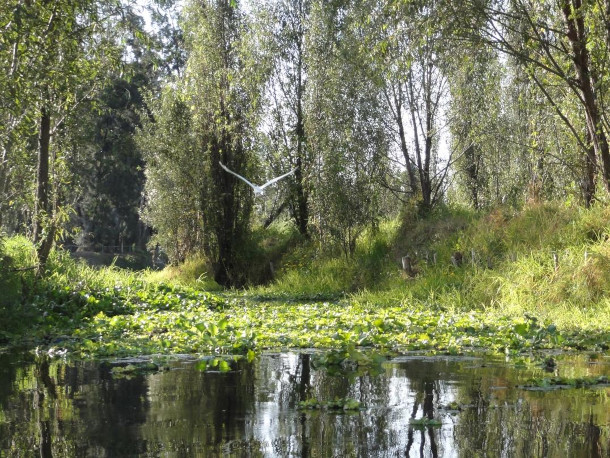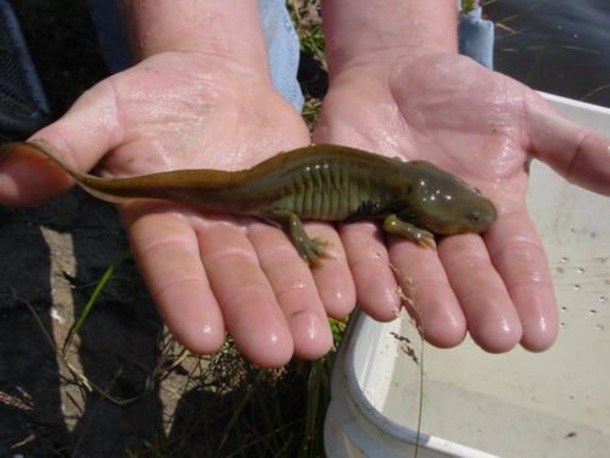Science Note: Axolotls Released to Wild
Air Date: Week of October 31, 2025

The axolotl (ambystoma maxicanum) is an aquatic salamander with external gills and a finned tail. (Photo: Mike Licht, NotionsCapital.com, CC BY 2.0)
Axolotls, aquatic salamanders with feathery gills that look like they’re always smiling, are endemic to a single lake in Mexico and critically endangered in the wild. Living on Earth’s Don Lyman reports on a successful release of captive-bred axolotls into wetlands that provides hope for boosting this unique creature’s wild population.
Transcript
DOERING: We head to Mexico now, where in some homes altars are brimming with gifts for departed loved ones. But first this note on emerging science about an amphibian endemic to Mexico, with a bit of a cult following.
[SCIENCE NOTE THEME]
LYMAN: Axolotls, aquatic salamanders with feathery gills that look like they’re always smiling. These amphibians are endemic to just one lake in Mexico. There are lots of axolotls in captivity, as pets or research animals, but there are estimated to be only 50 to 1,000 of the endangered salamanders left in the wild. But conservation biologists recently reported that releasing axolotls that were bred in captivity into restored and manmade wetlands, may help to bolster their populations.

Axolotls are endemic to Lake Xochimilco in Southern Mexico. Scientists have recently released one group of captive-bred axolotls into one of the lake’s restored canals. (Photo: Hernán García Crespo, Wikimedia Commons, CC BY 2.0)
A team led by Alejandra Ramos, a scientist at the Universidad Autonoma de Baja California in Ensenada, Mexico, released 18 captive-bred axolotls with implanted radio transmitters into two wetlands in Mexico City. One group was released into a restored canal in the axolotl’s native habitat — Lake Xochimilco, and the other into a pond in an artificial wetland. Researchers then tracked the aquatic salamanders for 40 days.
The scientists reported that all of the axolotls in the study survived, and three gained weight, indicating that they were successfully hunting prey in their new home. The data also showed that the amphibians traveled farther early in the experiment, perhaps exploring before they found hunting and hiding spots.

There are many axolotls kept as pets or used for research purposes, but only 50-1000 still exist in the wild, making them an endangered species. (Photo: Paul Hutchinson, Bureau of Land Management, Flickr, CC BY 2.0)
Reintroduction is really a plan B, said Luis Zambrano, an ecologist at the Universidad Nacional Autónoma de México in Mexico City. The researchers' main goal, Zambrano said, is to improve the aquatic habitat for axolotls already living in the wild.
That’s this week’s note on emerging science. I’m Don Lyman.
Links
Living on Earth wants to hear from you!
Living on Earth
62 Calef Highway, Suite 212
Lee, NH 03861
Telephone: 617-287-4121
E-mail: comments@loe.org
Newsletter [Click here]
Donate to Living on Earth!
Living on Earth is an independent media program and relies entirely on contributions from listeners and institutions supporting public service. Please donate now to preserve an independent environmental voice.
NewsletterLiving on Earth offers a weekly delivery of the show's rundown to your mailbox. Sign up for our newsletter today!
 Sailors For The Sea: Be the change you want to sea.
Sailors For The Sea: Be the change you want to sea.
 The Grantham Foundation for the Protection of the Environment: Committed to protecting and improving the health of the global environment.
The Grantham Foundation for the Protection of the Environment: Committed to protecting and improving the health of the global environment.
 Contribute to Living on Earth and receive, as our gift to you, an archival print of one of Mark Seth Lender's extraordinary wildlife photographs. Follow the link to see Mark's current collection of photographs.
Contribute to Living on Earth and receive, as our gift to you, an archival print of one of Mark Seth Lender's extraordinary wildlife photographs. Follow the link to see Mark's current collection of photographs.
 Buy a signed copy of Mark Seth Lender's book Smeagull the Seagull & support Living on Earth
Buy a signed copy of Mark Seth Lender's book Smeagull the Seagull & support Living on Earth

